The Mediterranean garden is a classic style of landscaping that is both beautiful and timeless. It’s defined by its use of warm colors, inviting pathways, and lush plants that evoke the warmth of the Mediterranean climate. Whether you want to create a cozy courtyard or an expansive outdoor living area, Mediterranean gardens can provide a unique setting for relaxation and entertaining.
The key to creating a successful Mediterranean garden is understanding the elements that make up this style. Here, we will explore some of the most commonly used elements in Mediterranean gardens as well as answer some frequently asked questions about Mediterranean garden design. We’ll also provide tips on how to start planning your own Mediterranean garden so you can begin creating a tranquil oasis in your own backyard.
What Is A Mediterranean-Style Garden?
A Mediterranean-style garden is a type of landscaping that evokes the beauty and warmth of Italy, Greece, and other regions near the Mediterranean Sea. This style usually features terracotta tiles, winding pathways, lush plants like olive trees and rosemary, as well as an abundance of flowers such as lavender, bougainvillea, and hibiscus. [1]
What’s In A Mediterranean Garden?
A Mediterranean Garden can be one of the most beautiful and exotic gardens you could ever have. From aromatic herbs and terracotta pots to a rustic stone pergola, these gardens are filled with fragrant plants, warm colours and stunning features – though all vary depending on region. Typically, they feature small trees, shrubs as well as herbs and vegetables. The vibrant colours, shapes and scents of the Mediterranean create a perfect atmosphere for relaxation and entertaining. [1]
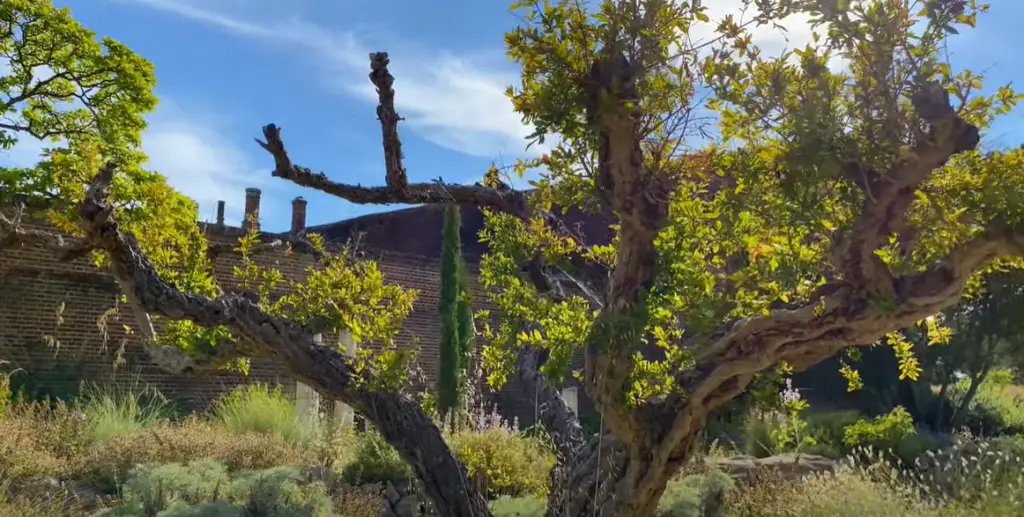
What Plants Grow Well In A Mediterranean Climate?
The Mediterranean climate is characterized by hot, dry summers and mild, wet winters. Plants that tend to thrive in this type of environment are those that can tolerate both drought and cooler temperatures. This includes plants like lavender, rosemary, thyme, bay laurel, and oregano. Other great options include fruit trees such as olives, figs, and citrus. Hardy shrubs like oleander and rosemary are also great options for Mediterranean gardens. [1]
How To Make A Mediterranean Garden?
Choose And Evaluate Your Site.
The first step in creating a Mediterranean garden is to choose a location with the right conditions. You’ll need plenty of sunlight, good drainage, and protection from strong winds. If you have an area that fits these criteria, then you can move on to evaluating it further. Consider what kind of plants would do well in your site’s soil and climate, and see how much space you have to work with. This will help you decide on a garden design that makes the most of its surroundings. [1]
Get Ideas
Once you have an idea of the kind of Mediterranean garden you’d like to create, it’s time to get inspiration from other gardens. Take a look at magazine articles, books, and websites for ideas on how to bring your vision to life. You may also want to visit some local public gardens or take a trip out of town to see how different regions of the world interpret Mediterranean gardening. [1]
Create A Plan
Before you begin purchasing plants and supplies, create a comprehensive plan that includes the types of plants and features you’d like to include. Make sure to consider things like color, texture, height, and shape when deciding what will go where. You may also want to draw up a list of materials that you’ll need for construction projects such as raised beds, terraces, or walls. [1]
Consider Scale
When designing your Mediterranean garden, make sure to take its size into account. If your garden is small, then you may want to focus on a few select plants rather than trying to cram too many varieties in one spot. On the other hand, if you have a lot of space to work with, then you can get creative with large trees, shrubs, and other features. [1]
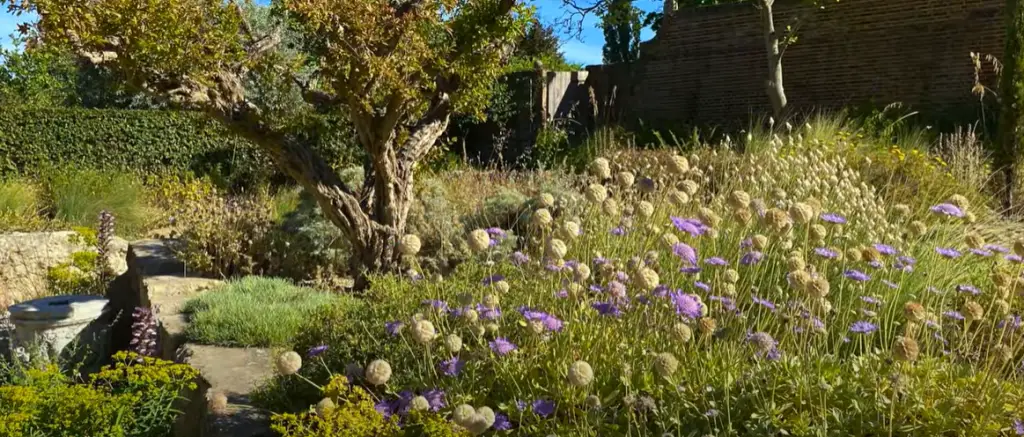
Consider Style
Finally, think about the style of your Mediterranean garden. Do you want a formal look? A hint of rustic charm? Or something else entirely? There are many different approaches to creating a Mediterranean garden, so make sure to choose one that reflects your own aesthetics. Once you have an idea of what you’d like to achieve, it’s time to start making it a reality. Good luck! [1]
Mediterranean Garden Elements
Shade
The Mediterranean climate is known for its hot, dry summers and mild winters. As such, plants that thrive in this climate need to be able to withstand long periods of sun and heat. The best way to do this is by using shade plants. These are plants that will help keep your garden cool even during the hottest days of summer while also providing an attractive, lush backdrop for your garden. Some popular shade plants for Mediterranean gardens include olive trees, cypresses, and grapevines. [1]
Water
Mediterranean gardens are also known for their water-wise landscaping. This means they use low amounts of water to maintain a beautiful and healthy garden. When planning your Mediterranean garden, choose plants that need little to no watering so you won’t have to worry about constantly watering them. Some popular drought-tolerant plants include lavender, rosemary, and thyme. [1]
Outdoor Living Spaces
Creating a comfortable and inviting outdoor living space is an essential part of Mediterranean-style gardening. Think cozy seating areas with comfortable cushions, fire pits for evening conversation and roasting marshmallows, and other amenities such as outdoor kitchens or bars. These elements will turn your garden into the perfect spot for entertaining family and friends. [1]
Containers
Containers are a great way to add color, texture, and interest to any Mediterranean-style garden. If you have limited space for planting beds, use colorful containers filled with drought-tolerant plants such as succulents or herbs. This will create attractive focal points for your garden that require minimal maintenance. [1]
Stone, Pavers, And Gravel
Stone and gravel are a classic element of Mediterranean-style gardens. They help provide a solid foundation for plants and provide a durable, low-maintenance surface for pathways or seating areas. Pavers can be used to add texture and color to your garden while also providing the necessary support for outdoor living spaces. [1]
Tile
Tile is the perfect way to add a splash of color and pattern to your garden. There are so many options available, from bright and bold patterns to more subtle designs that will complement your plants. Use tiles to break up large areas of stone or gravel, or use them as pathways throughout your garden. [1]
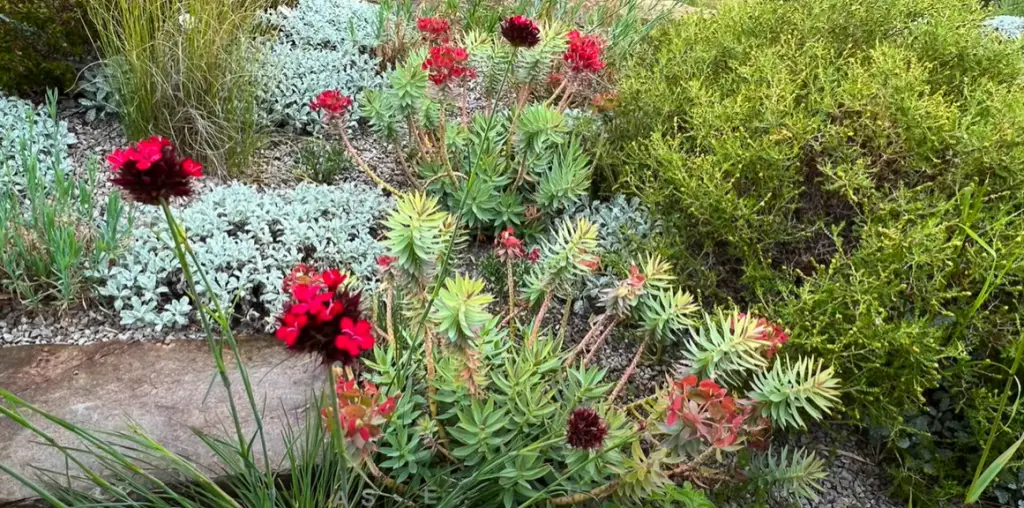
Fragrance
Adding fragrant plants to your Mediterranean garden will create a dreamy atmosphere. Lavender and rosemary are two of the most beloved choices, as their scents are reminiscent of the Mediterranean region. Other options include jasmine, lemon verbena, and bay laurel. [1]
Color
Adding color to a Mediterranean garden is the perfect way to make it feel warm and inviting. Choose flowers in shades of yellow, orange, pink, red, and purple for maximum impact. Plus, they’ll attract beneficial pollinators like bees and butterflies which are essential for a thriving garden. [1]
Mediterranean Plant Design
Drought-Tolerant Plants
Drought-tolerant plants are a must for a Mediterranean garden, as these regions often experience long periods of dryness. Select hardy and drought-tolerant species that can cope with the hotter temperatures and limited water supply. Succulents, such as cacti and agave, are great options for these gardens, as they do not require much water and can easily tolerate hot temperatures. Other drought-tolerant plants to consider include lavender, rosemary, and yarrow. [1]
Plants With Foliage Interest
In the Mediterranean, you’ll find plants with interesting foliage as well as vibrant flowers. These types of plants can add texture and color to your garden design. Some excellent choices include olive trees, rosemary shrubs, and lavender bushes. Ferns are also a great choice for Mediterranean gardens since they require minimal care and water. [1]
Vining Plants
Vining plants can be a great way to add dimension and texture to your Mediterranean garden. Bougainvillea, jasmine, and clematis are all excellent choices for these gardens, as they thrive in hot climates with little water. These vines will provide your garden with vibrant color throughout the year. Plus, the blooms will attract bees and butterflies! [1]
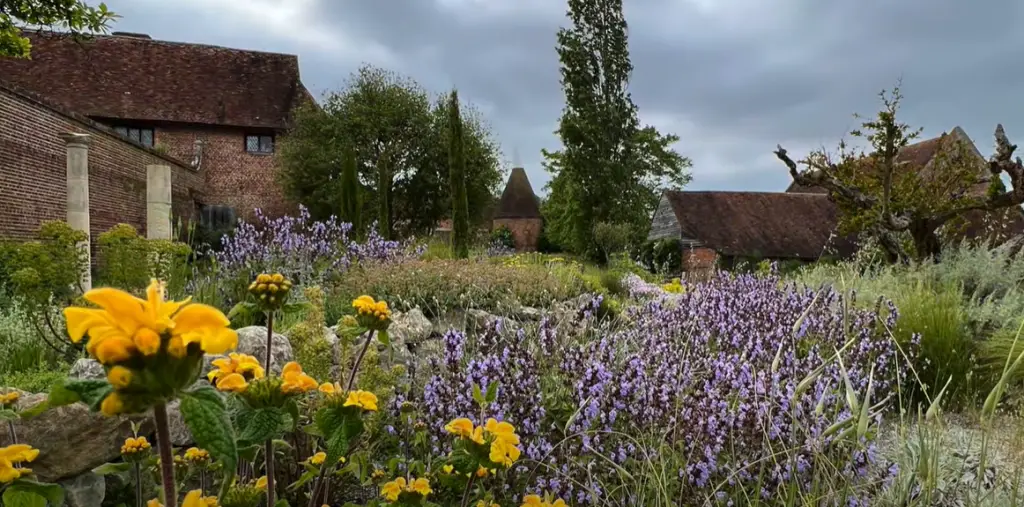
Clipped Hedging And Topiaries
Topiaries and clipped hedging are a great way to add structure and form to your Mediterranean garden. Boxwood, rosemary, lavender and olive trees are all excellent plants for topiary work. With careful pruning, these plants can be shaped into beautiful works of art that will bring visual interest to your garden. [1]
Mediterranean Trees
Mediterranean trees can bring a sense of grandeur to your garden, helping to create a truly unique and beautiful space. Olive and cypress trees are classic choices for these gardens, as they can handle the hot temperatures and require little water. Palms are also a stunning option for Mediterranean gardens, providing some welcomed shade during the hotter months. [1]
Waterwise Succulents
Succulents are a great choice for Mediterranean gardens, as these plants require little water and can tolerate hot temperatures. Aloe vera, jade plant, and cacti are all excellent choices for these gardens. Plus, they add interesting shapes to your garden design with their unique foliage and blooms. [1]
Citrus Trees
Citrus trees are another classic option for Mediterranean gardens, as they do well in hot temperatures and require little water. Lemon, lime, and orange trees can all make for an interesting addition to your garden design. Plus, you’ll be able to pick fresh citrus fruit from your own backyard! [1]
Ornamental Grasses
Ornamental grasses are a great way to add movement and texture to your garden design. These plants require minimal care and can handle hot temperatures with ease. Some excellent options include purple fountain grass, liriope, and blue oatgrass. They have graceful foliage that will bring visual interest to any Mediterranean garden. [1]
Ground Covers
Ground covers are a great way to add green color to your garden without taking up too much space. Some excellent options for Mediterranean gardens include creeping thyme, creeping rosemary, and vinca minor. These plants will provide your garden with plenty of greenery throughout the year. [1]
How To Plant & Maintain A Mediterranean Garden
Light.
The Mediterranean climate is known for its mild winters and hot summers, so your plants need to be able to adapt to both. Plants that do well in this kind of climate include citrus trees, cypresses, olives, lavender and roses. Choose sun-loving plants that thrive in dry soil and mulch regularly to keep them healthy. [1]
Soil
The soil in a Mediterranean garden should be well-draining and have plenty of organic matter to provide the right balance of nutrients for your plants. Add compost or aged manure to improve fertility and pH levels, as this will help ensure that your plants get enough water, oxygen and essential minerals. [1]
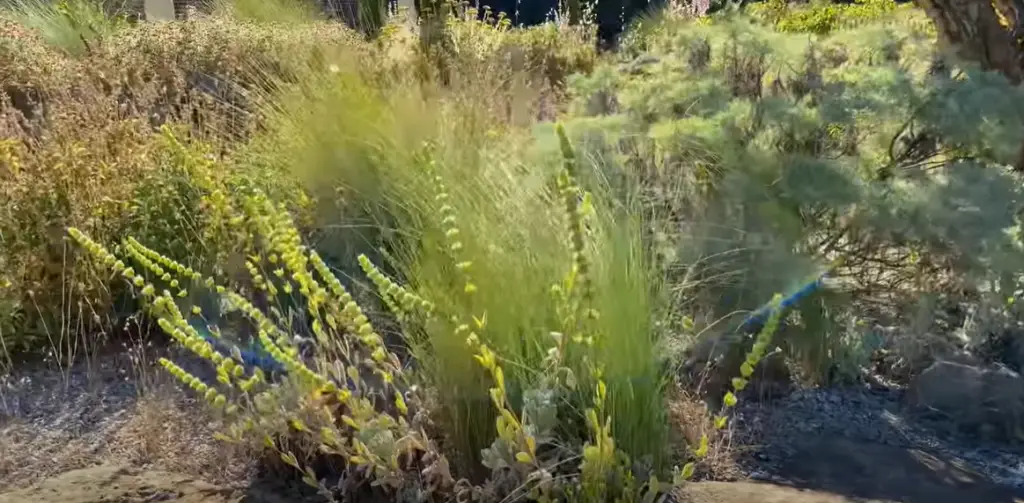
Water
When it comes to watering in a Mediterranean garden, less is more. Make sure you water your plants regularly but don’t overdo it – too much water can cause root rot and other problems. Use drip irrigation systems or soaker hoses to ensure that your plants get the right amount of water without wasting any. [1]
Prune
You should prune your plants regularly to keep them healthy and encourage new growth. Pruning is especially important for woody plants such as rosemary, lavender, thyme and olives as it helps promote more branching and a denser foliage. Make sure you use sharp garden tools to avoid damaging the plant. [1]
FAQ
What do you put in a Mediterranean garden?
When designing a Mediterranean garden, you have a variety of plants to choose from. Think about adding elements such as olive trees, cypress trees, and lavender for a classic look. You can also add some herbs such as rosemary and oregano for that beautiful scent. Don’t forget the colorful flowers like bougainvillea, hibiscus and daisies. You can also add some citrus plants like oranges and lemons to give your garden a sweet aroma.
How do you make a Mediterranean garden?
Creating a Mediterranean garden is not as difficult as it seems. Start by deciding what kind of look you want to achieve and then choose your plants accordingly. If you want a classic Mediterranean look, add plants such as olive trees, cypress trees, lavender, rosemary and oregano. For the colorful flowers, think about adding bougainvillea, hibiscus and daisies. Finally, finish off your garden with some citrus plants like oranges and lemons to give it a sweet aroma.
What plants are used in a Mediterranean garden?
When designing a Mediterranean garden, you should choose plants that are suited to the climate of the region. Some common plants include olive trees, cypress trees, lavender, rosemary and oregano. For the colorful flowers, bougainvillea, hibiscus and daisies are commonly used. Finally, adding citrus plants like oranges and lemons can give your garden a sweet aroma.
What color is a Mediterranean garden?
The colors of a Mediterranean garden can vary depending on the plants you choose. A classic Mediterranean look would include shades of green, white, and purple from the olive trees, lavender, rosemary and oregano. The flowers can add vibrant pops of color such as orange and yellow with bougainvillea, hibiscus, and daisies. Finally, the citrus plants like oranges and lemons will add a sweet aroma to your garden.
What are classic Mediterranean colors?
The classic colors of a Mediterranean garden are shades of green, white, and purple. Olive trees, lavender, rosemary and oregano all lend to this look. You can also add vibrant pops of color with bougainvillea, hibiscus and daisies in oranges and yellows. Finally, citrus plants like oranges and lemons will add a sweet aroma to your garden.
What is the Mediterranean garden style?
The Mediterranean garden style is a classic, timeless look that features plants commonly found in the Mediterranean climate. Think about adding olive trees, cypress trees, lavender, rosemary and oregano for the green elements. For the colorful flowers, bougainvillea, hibiscus and daisies are all great options.
What are the 3 features of a Mediterranean house?
The three main features of a Mediterranean house are arches, terracotta roofs, and stucco walls. Arches create a beautiful aesthetic and also provide an extra layer of protection from the elements. The terracotta roof will help to keep your home cool during the hot summer months. Finally, stucco walls give your home a timeless Mediterranean look.
Useful Video: Designing a Mediterranean Style Garden
Conclusion
Thanks for exploring Mediterranean Garden Ideas with us! As you can see, there are countless options when it comes to bringing the beauty of the Mediterranean into your outdoor space.
Whether you’re looking for low-maintenance plants that require little water and minimal care or potted plants that will thrive in a sunny spot on your patio, there’s something for everyone. Depending on the size of your garden and the time you have available, you may opt to create a stunningly intricate landscape – or just fill it with simple, cheerful blooms.
If you want to start small but still make an impact, consider planting a few olive trees in decorative containers. Their distinctive silver-green leaves will give your garden an unmistakably Mediterranean touch.
No matter what you choose, designing a Mediterranean-style garden can be a great way to add some style and character to your outdoor space. With the right plants and design tips, you’ll have everything you need to make it happen.
References:
- https://www.gardendesign.com/landscape-design/mediterranean.html










Leave a Reply
View Comments